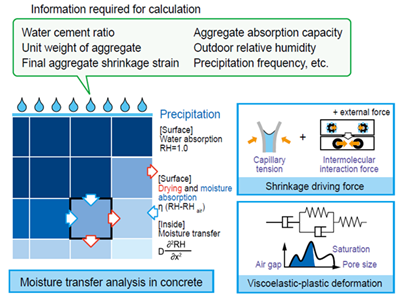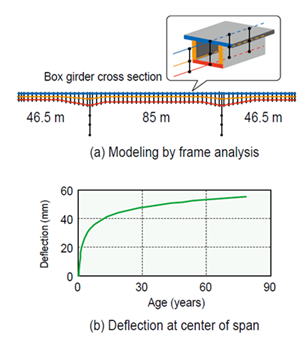28. Prediction Method for Long-term Deformation Behavior of Concrete Bridges Considering Water Content Conditions
Long-term deformation of railway concrete bridges affects vehicle running performance and track maintenance. This impact is especially pronounced in high-speed railway bridges. With advancements such as diversification of structural types and lengthening of spans, the importance of methods to estimate deformation throughout the entire service life is increasing. In addition, there is a growing need to address how changes in the construction and maintenance environment, such as climate change and shortages of high-quality construction materials, are reflected in design practices.
We developed a shrinkage strain analysis program that calculates the time-dependent changes in water content distributed within concrete based on moisture transfer analysis using diffusion theory. The program predicts the shrinkage-driving force and deformation amount of the concrete up to 100 years ahead according to the water content (Figure 1). By macroscopically capturing physical and chemical phenomena such as hydration in concrete, the amount of information required for calculations is greatly reduced. Using only information measurable in practical work, the program calculates shrinkage strain according to water content conditions and mix proportions. By inputting this shrinkage strain into a structural analysis tool (frame analysis) using steels or beam elements that consider member shapes, the long-term deformation amount of concrete bridges is calculated (Figure 2). The validity of this method has been confirmed by comparing the calculated shrinkage strain using precise methods and the measured deflections of bridges.
Because this method can flexibly respond to construction and maintenance conditions, it contributes to the advancement of design methods for long-term deformation of bridges caused by concrete shrinkage. It is expected to be used for proposing rational new structural types that control the effects of shrinkage and creep, as well as for reducing maintenance.
Other Contents
- 27. Method for Estimating the Density of Newly Fallen Snow Using Dual-polarization Radar
- 28. Prediction Method for Long-term Deformation Behavior of Concrete Bridges Considering Water Content Conditions
- 29. Non-contact Disc Brake Enabling Power Regeneration in Trailers
- 30. Method for Reducing Unstable Vibrations of Pantographs Caused by Sliding Friction
- 27. Method for Estimating the Density of Newly Fallen Snow Using Dual-polarization Radar
- 28. Prediction Method for Long-term Deformation Behavior of Concrete Bridges Considering Water Content Conditions
- 29. Non-contact Disc Brake Enabling Power Regeneration in Trailers
- 30. Method for Reducing Unstable Vibrations of Pantographs Caused by Sliding Friction


